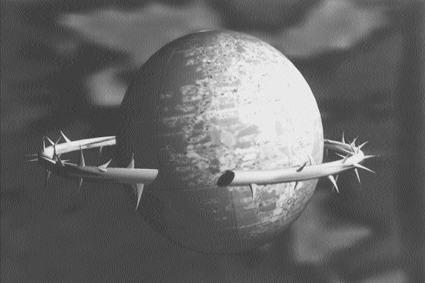Auditory display? Puzzled faces and a momentary whirring of cogs are not uncommon responses to hearing this phrase for the first time. What it quite broadly refers to is the use of audio in computer systems. But perhaps the spontaneous sense of contradiction thus conjured goes to the heart of what is most interesting in this area: How do you bring together computers, scientists and sound? And why?
As an event the International Conference on Auditory Display, ICAD ‘97, was highly interdisciplinary, bringing together participants from academia, industry and the arts, sporting a plethora of technical knowledges and creative applications—people with backgrounds in everything from computer music to rocket science, all of whom use sound in some way to communicate information at the interface.
This conjunction of audio and computing is interesting because it requires a bringing together of the discrete symbolic operations of computers with the indiscrete resonant operations of sound. Sounds mix in space and overlap in time. The current interest in audio amongst computing professionals and scientists is connected to major changes in how we conceptualise computer capabilities…No longer the box on the desk! Computing is breaking out as an emerging rash of ubiquitous and diverse and much more specialised gadgets and applications. As computing takes place less and less in the other worlds that we picture through our monitor screens, and more and more in our physical environments, sound has an important role in integrating computer functions into physical space.
The relationship between computing and the visual interface however has a particular history which complicates the adoption of audio as an interface paradigm. The development of the visual display to replace punched cards and text printers as the dominant interface for input to and output from computers came from a scientific culture which sought to represent and manipulate discrete symbolic operations of computers directly through the screen which acted as a window on a world which was quantifiably known. The computer screen carries the baggage of ways of looking and thinking and knowing that are as old as writing.
ICAD as a whole attempted to reconcile the contradictions inherent in the relationships between computing science and sound design by creating a framework for addressing the cultural problems of bringing together such a range of disciplines. So too the work demonstrated and discussed on the whole attempted to bring these paradigmatically divergent modes together.
Sessions included a huge range of approaches. Some used the properties of sounds and their capacity for providing background awareness or spatial information as enhancements to existing data zones, such as a presentation by Beth Mynatt and Maribeth Back on work they are doing on Audio Aura: a lightweight audio augmented reality which used thoughtfully designed sounds to enhance awareness of workplace activity and interaction. At the other end of the scale were presenters bent on attributing absolute empirically proven meanings to certain kinds of sound events; these tended to make very blunt assumptions about the representational meanings of sounds such as failures to distinguish in a meaningful way between, for example, the sound of a real musical instrument and a badly synthesised midi equivalent. In reproducing sounds, the apparatus of recording reproduction and the space in which the sound occurred, as well as the space in which the sound is replayed, all affect the quality and meaning of the sound.
To balance the sometimes simplistic approaches to the material meanings of sounds, a number of special sessions were organised to introduce a diversity of sound art and design issues to the predominantly technical scientific community. An after-dinner panel comprising Paul deMarinis, Ed Osborn, Tim Perkis and Bill Viola presented a range of perspectives on sounds, silence and listening. Paul deMarinis discussed a history of the sounds which have signified silence from the soft introductory passages of eighteenth century orchestral music to the line noise of telephone systems, sounds which indicate an immanent listening space. Tim Perkis gave an interesting talk on different levels of listening attention, proposing a particular mode of not listening, or not listening with conscious attention as an important and valuable listening mode for sound workers to consider. Osborn and Viola discussed their work. On the last night, delegates were treated to Pauline Oliveros’ Deep Listening experience in which the audience performed for the first 40 minutes—a strategy which created conditions for a particular kind of open listening for Oliveros’ following accordion performance. By contrast, in the closing session of the conference, sound designer Mark Mancini demonstrated sound design techniques from Speilberg blockbusters and Ben Burtt’s classic work on Star Wars.
It seems inevitable that the convergence of sound and computing will change cultural perceptions of both computing and sound. Perhaps the increased use of audio in computing and the dispersal of computing from the box on the desk will bring different ways of listening and knowing into play in the day to day use of computers.
The sheer diversity of ICAD and the seriousness with which it addresses the complexities of such an interdisciplinary event make it an important contribution to these shifts in the culture of computing.
ICAD ’97, Xerox PARC, Palo Alto November 2-5 1997. ICAD ’98 November 2-4, hosted by the University of Glasgow’s Department of Computing Science; queries icad98_info@santafe.edu. ICAD website http://www.santafe.edu/~icad
RealTime issue #23 Feb-March 1998 pg. 39
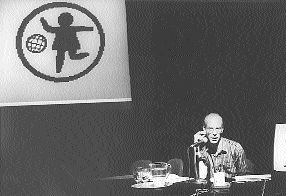
Geert Lovink, Code Red
photo Heidrun Löhr
Geert Lovink, Code Red
Code Red was the third in a series of Australian Network for Art and Technology initiated events over the past few years bringing international new media artists and theorists to Australia to engage with Australian practitioners and theorists. The previous initiatives, Virogenesis 1 & 2, curated by Francesca da Rimini, played on the metaphor of viral infection and replication, with international guests, Graham Harwood, Matt Fuller and E. “Gomma” Guaneri, spreading their own strain of subversive politicised commentary on new media culture and production and finding willing hosts and co-conspirators in the Australian new media community.
Building on the successes of these earlier events, Code Red, curated by Julianne Pierce, brought together an impressive lineup of international and Australian-based theorists and artists to interrogate and critique contemporary information culture. Following the theme suggested by its title, Code Red acted as a timely alert or call to arms for the Australian new media arts community drawing attention to the growing commercialisation and state/corporate control of contemporary media and information culture as well as suggesting strategies for intervention and resistance. It is only possible to give a small taste of these presentations here but if your tastebuds are stimulated keep an eye on the ANAT website http://www.anat.org.au/projects where the papers will be going up soon and you can find links to related websites.
In his keynote address, “Strategies for Media Activism”, Geert Lovink (Netherlands) outlined his personal commitment to “cyber pragmatism and media activism” in the face of an international climate of increasing media monopolies, surveillance and censorship. “New media is a dirty business, full of traps and seductive offers to work ‘for the other side’”, he cautioned, suggesting that artists and activists need to develop and defend spaces on the internet which are independent of both state and commercial interests. By way of example he discussed the practice of a number of autonomous organisations in Europe which are working to promote access to and critique of new media.
Jeffrey Cook (Australia) also spoke of the need for techno-activism and the importance of a critical art practice in maintaining “a radical position in the homogenous soup of mainstream media and information”. The imminent prospect of webTV threatens to undermine the most positive and productive feature of the internet, its facilitation of many-to-many communication with active participation by users to a dumbed down space for endless re-runs of sitcoms, commercials and infotainment. Free speech and expression of ideas on the internet are also under threat in Australia from a proposed web rating system that would require ISPs to ensure that all the websites they host carry a rating which will distinguish ‘safe’ from ‘unsafe’ websites. This would allow browsers to lock out ‘undesirable’ sites leading to further marginalisation of much of the more challenging and creative content.
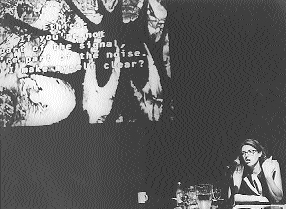
Linda Wallace
photo Heidrun Löhr
Linda Wallace
In her presentation, “Luminous”, Linda Wallace (Australia) took a pragmatic approach to the vexed questions of corporate/state funding for artists, challenging notions that corporate money is “dirty” and state money “pure”. She emphasised the fundamental importance for artists of the work itself and “having the space and time and funds to create it”. She drew on her own experience of seizing opportunities in either the state or corporate sector and performing the difficult juggling act of “taking the funds but still having the space to speak freely”.
The final two presentations were by artists. Australian new media artist Brad Miller’s “Art in the Age of Collaboration” discussed and advocated the collaborative art practice that is a feature of much new media work such as Miller’s own collaboration with theorist McKenzie Wark in the production of the CD-ROM Planet of Noise. In “The Production of Visibility”, Cornelia Sollfrank (Germany) described strategies for parodying and subverting the power structures and advertising images of the media, business and public authorities. Using a technique of “over-coding”, she takes already existing media images from advertising and promotional material (a technique she calls “ready-aesthetics”) and subjects them to a process of “concept-hacking” to make visible their latent power-strategies. Cornelia is also a founding member of the German new media performance group Innen who use similar techniques and have successfully infiltrated European computer fairs posing as trade fair assistants handing out mousemats with subversive messages to unsuspecting delegates.
In addition to the main conference, Code Red included a number of artist projects and presentations in The Performance Space gallery. Visiting from Slovenia, Marko Peljhan’s exhibition and performance piece 178 EAST—ANOTHER OCEAN REGION was the culmination of a two week residency at The Performance Space researching Australian telecommunication laws and using satellite technology to intercept transmissions in the radio space above Australia. Part of this research resulted in a guest appearance by Adam Cobb (Visiting Research Fellow, Strategic and Defence Studies Centre, ANU, Canberra) and the grafting of a satellite dish onto the roof of The Performance Space. Marko’s performance elicited audience complicity as participants were required to sign a confidentiality agreement stating they would not seek to record or disclose any of the intercepted material they were eavesdropping on.
Also dealing with themes of surveillance and privacy was Australia-based Zina Kaye’s (Humble Under Minded) Psychic Rumble Part 2 which recorded and broadcast over the internet ambient sounds and mutated snatches of conversation from The Performance Space gallery. Another event taking place in the gallery on the day of the conference was an on-line performance The Word: The Wall directed by Ann Morrison exploring the anarchic lives and environments of three virtual characters.
One of the most productive and useful features of Code Red was its facilitation of on-going debate and discussion between conference delegates and participants. Issues raised in the conference itself were followed up on subsequent days with two roundtables. The first (led by Geert Lovink and Australian media theorist McKenzie Wark) focussed on new media theory and strategies for communication and critique, the second (led by Cornelia Sollfrank and Julianne Pierce) discussed cyberfeminist practice and the creation of a ‘global’ cyberfeminist movement, issues that were the focus of the First Cyberfeminist International held during last year’s Documenta X in Kassel.
A Code Red outcome of particular interest to the Australian new media community is the creation of a new Australian/Asia Pacific email mailing list. The list :::recode::: will be hosted by autonomous.org (System X) with support from ANAT and will be a site for critical commentary and debate by practitioners and critics on contemporary new media, online and digital culture as well as providing an outlet for publishing material online. Those interested in subscribing to the list or who want more information should contact the list moderator: owner-recode@autonomous.org [expired]
Code Red was a project of the Australian Network for Art and Technology and The Performance Space curated by Julianne Pierce with support from the New Media Arts Fund of the Australia Council, the Goethe Institut, ABC Radio and the Arts Law Centre of Australia.
RealTime issue #23 Feb-March 1998 pg. 23
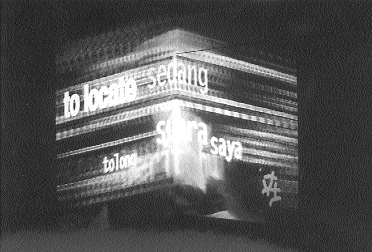
Hasnul Jaimal Saidon, I’m Trying to Locate, black & white video projection
photo Peter Spillane
Hasnul Jaimal Saidon, I’m Trying to Locate, black & white video projection
There is, it might be argued, a kind of ‘techno-orientalism’ surrounding new technologies when thinking the machine, soft-space and the digital-image in the western psyche: a pairing of high end technology with Asia in the western imaginary, if you will, however empirically inaccurate.
It gives rise to a ponderous situation where westerners operate with a technology and therefore a thinking which they do not ‘own’. When using new imaging technologies in the visual arts—if the modernist Greenbergian axiom around form and content and a Benjaminian assertion regarding the complex form of training imposed by modern technology can be indulged—what results is a kind of ‘blank canvas’ at the heart of thinking the digital image.
It was in this light that encountering the First National Electronic Art Exhibition at the Malaysian National Gallery in Kuala Lumpur raised particular considerations. If granted the license to think speculatively for a moment, one might wonder if the aniconic formulation of the image particularly in traditional Muslim art as it influences contemporary artists working with multi-media technology in Malaysia, does not somehow afford a greater propriety towards the digital image (if this is not to engage in a kind of [techno-]orientalism itself of another order).
The confounding of historical concepts of representation and analogy in western philosophies of the image are well documented in relation to the digital image (Binkley, T “The Digital Dilemma”, Leonardo, Supplemental Issue, Pergamon Press, Japan, 1997). What marks eastern philosophies of the image, particularly within the Islamic tradition, is the aniconic as opposed to iconic relation to the image that exists in the west. The aniconic are those images and symbols relating to deities that are non-figurative or non-representational.
Within Islam, Allah is inexpressible therefore non-representational. “No vision can grasp Him…” (Qur’an [Koran], 6:103). The spiritual order determines the aesthetic-formal order. Stylisation techniques exercised in calligraphy, illumination, geometric pattern and arabesque form the foundations for a tradition where the artwork in fact functions as a ‘cosmogram’. Not only does the aniconic concept of art in Islam make for an art practice arguably predisposed to a knowledge and use of the digital image—“knowledge and use” here in the Deleuzian sense of ‘savior’ which is an ability to make active, “a knowledge by description”, “a competence to produce” rather than reproduce (Deleuze, G. Negotiations, Columbia University Press, USA, 1995). But the ‘cosmogrammatic’ nature of the artwork when applied to the digital image overrides criticism often raised in relation to the electronic image in the west: that it is slick, glossy, dazzling, decorative, all surface and therefore superficial.
Surface ornamentation is the core of spiritualising enhancement, not a superficial addition in the Islamic concept of the artwork. This is not to add foreign elements to the shape of the object but to bring forth its potential, ennobling the object. “Through ornamentation the veil that hides its spiritual and divine qualities is lifted.” (Esa, S. Art and Spirituality, National Art Gallery, Malaysia, 1995) In Islam, beauty is a divine quality, God is beautiful and loves beauty. Beauty in art is that which generates the sense of God. Since beauty is a divine quality its expression has to be made without showing subjective individualistic inspiration. There is therefore no distinction between the material and spiritual planes. In creating beauty the artist is engaged in a form of spiritual alchemy and in doing so the soul of the artist undergoes a process of spiritual cleansing. This raises some very different notions around the artwork than those generated in the west around questions of abstraction, the sublime and the beautiful.
This is also not to say that the works exhibited during the First Electronic Art Exhibition in Kuala Lumpur were traditional in terms of technique or concepts. Far from it. The works that drew upon traditional methods or concepts did so with a rigorous critical distance and engagement. Nor were the traditional methods and form that were used and conceptual frameworks employed exclusively Muslim. Hindu, Taoist, animist and Christian traditions and metaphysics also come into play in Malaysian culture. But most contemporary artists in Malaysia have trained under a western art history syllabus with the majority, it seems, completing graduate degrees in the west. So there is certainly an engagement with western art history and art markets but often put to work in relation to eastern systems of ideas.
Mohd Nasir Bin Baharuddin’s four monitor video floor piece, for instance, works precisely in this manner. It encourages a deceptively pious response, although for a westerner one is even less sure why. The viewer is ceremoniously positioned by the work—submitting to its lure, sitting submissively at its feet, as it were, encircled by silent monitors across the soft opaque screen of which, runs a fluid arabic calligraphic script. The effect is mesmeric and contemplative. However as the artist, who is also the curator at Gallery Shah Alam, points out to a Muslim observer there would be questions as to why the monitors containing sacred script have been placed on the floor, indicating a lack of reverence. The script, however, is not from the Qur’an but Jawi, an arabic script spoken in Bahasa Malaysian (which is also written in a roman script) and which in fact many Malaysian Muslims do not even read themselves. And the text, far from being the word of god is everyday diary extracts. Baharuddin’s trick is a gentle one and works along side the temporal enquiries of the work, which are figured so that the piece never ‘begins’ as such. An allusion perhaps to the ‘awan larat’ (arabesque), a pattern so interconnected that it is impossible to trace the beginning of each motif. Within the installation the viewer is placed in one physical position but one which triggers many different and simultaneous readings of the position. The space in the midst of the monitors is also the space of the traditional cross-legged village story-teller, but the ‘audience’ of monitors tell story fragments that becomes the viewer’s, the ‘centre-piece’s’ own, confusing the places of teller, told and tale.
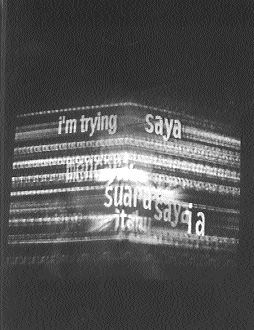
Hasnul Jaimal Saidon, I’m Trying to Locate, black & white video projection
photo Peter Spillane
Hasnul Jaimal Saidon, I’m Trying to Locate, black & white video projection
Hasnul Jaimal Saidon’s CD-ROM work, Ong (slang for “hot streak”), from his solo show Hyperview, was shown along with his I’m trying to Locate, a video-projected, corner piece that creates the optical illusion of a three dimensional space out of a flat wall. The black and white piece uses Chinese pictograms, English and Bahasa scripts over a textured electronic weave evoking traditional Songket. Textiles, historically have a sacred and ceremonial function as does calligraphic script which is said to be “the divinely written pre-eternal word which brings the faithful into immediate contact with the Divine Eternal Writer of fate and from there even profane writing has inherited a certain sanctity.” (Islamic Calligraphy, Leiden, 1970) This work and the others exhibited, while either overtly concerned, less so or not at all, with contemporary interpretations of traditional Malaysian cultural forms, never dip into parochialism. The works could function in the context of any international gallery in addressing the medium to be read along side works by Gary Hill, Mary-Jo La Fontaine or Eder Santos.
Hasnul, who also heads the Fine Arts Programme at the University of Malaysia, Sarawak, curated the exhibition with Niranjan Rajah whose on-line work The Failure of Marcel Duchamp/Japanese Fetish Even! is available on http://wwwhgb-leipzig.de/waterfall/ [link expired]. The piece is a parody of Duchamp’s Etant Donnes which, in Rajah’s words, interrogates the ontology of imaging while marking the problem of cultural constituencies on the internet.
The historical component of the exhibition saw the mounting of a posthumous retrospective of the work of Ismail Zain, a veteran in the field of computer art. Ironically computer art was being produced by Zain and others in Malaysia before video art, which did not come until after computer art had been explored and developed. In producing collages reminiscent of early political photo collage, Zain said of his work “in digital collage there are no harsh outlines. The new medium is much more malleable, like clay”. (Noordin Hassan interviews Ismail Zain, Ismail Zain retrospective exhibition catalogue, National Art Gallery of Malaysia. 1995)
Ponirin Amin, one of the country’s leading printmakers exhibited a number of woodcut/computer prints, as did Dr Kamarudzaman Md. Isa. The strong traditions of printing, textiles and woodcutting saw these forms being integrated with computer generated elements to produce object based works, which ironically overcome the complaint among artists operating in the west have about the lack of collectability and therefore saleability of work in new media.
Other works included those by Wong Hoy Cheong, the Matahati Coterie, British, Kuala Lumpur-based artists David Lister and Carl Jaycock, a 3D animation using wayang puppets, screen and live performance as well as pieces from YCA (Malaysia’s Primavera) and winners from the Swatch Metal Art Award, Bayu, Kungyu and Noor.
RealTime issue #23 Feb-March 1998 pg. 25
Thinking I’d arrived late to the opening address by Zoë Sofoulis for the conference of the multi-component event Women on the Verge of New Technology (hereafter WoVNT), I took a back seat at Kulcha, scanned the room, as one does, and quickly came to the realisation that it was not women but men who were ‘on the verge’ of this cultural-technological situation. I was one of perhaps five men in a venue otherwise filled with women, maybe 60. An audience this size, regardless of sex, translates as a successful event for a critical arts happening in Perth.
In the terms suggested by Sofoulis in her paper which drew on “actor-network theory” (ANT) by Bruno Latour and Daniel Stern’s psychoanalytic notions of ‘inter-subjectivity’, male or female positionality shouldn’t make a difference based on binary distinctions. With ANT, the space of culture and society and everything else in the world is no longer defined through core-periphery, interior-exterior models; humans are no longer defined as subjects negotiating a field of objects, or by their gender identity or biological sex, but rather as elements of varying intensity performing strategic connections within networks that might include artworks, institutions and new technologies. (See Zoë Sofoulis, “Interactivity, Intersubjectivity and the Artwork/Network”, Mesh 10, Spring, 1996. See also Bruno Latour, On Actor Network Theory: A Few Clarifications, http://www.keele.ac.uk/depts/stt/stt/ant/latour.htm [expired]) However, the problematic of consciousness, and hence human agency, still lingers with Latour’s notion of strategic connections: without consciousness, how can either a human or non-human actant have a strategic capacity? We start heading down the path of proto-subjectivity here…and I don’t wish to go there, just yet.
The relationship between women and technology can be thought of in terms of the extent to which artworks produced by women, among others, are commodified, and the effect this has in terms of institutional-market cooptation. This prompts the question, what becomes marginalised as some artworks, artists, curators, administrators and academics ascend the ladder in the emergent culture industry of all things digital? Despite the deification of the internet and, by association, computer generated art, for its capacity to abolish the banality of geographic distance and almost overcome the download weariness of time-lag, the traditional Melbourne-Sydney cultural-economic nexus maintains its monopoly on who and what gets a guernsey. That is to say, cultural forms and practices still take place, constituting a verge beyond which a different culture happens as a provincial one. Herein lies the apparent incommensurability of the time of new communication technologies with the dreck of everydayness.
On paper, WoVNT appeared as a diverse, comprehensive and ambitious event. Along with its central act—a two day conference with speakers from academic, administrative, performance, and ‘Digitart’ practitioner backgrounds—WoVNT included a web design workshop; demonstrations on the use of digital technologies in Yamaji and Nyoongar historiography, biomedical research, and stock marketeer entertainment; and Leah Irving’s video installation whose representation of Millias’ ‘Ophelia’ engaged wistfully with but didn’t exactly challenge the ‘gaze’ of this viewer as he circumambulated her outer electro-sensory reaches. Unfortunately the ‘virtual component’, TechnoLust: Desire and Technology, never virtualised. Computers were stolen from Antwerp’s MCA a few days prior to transmission, preventing big-name lectures by the likes of Constance Penley, Rosi Braidotti, Linda Dement, Vivian Sobchack, and Claudia Springer, and video and CD-ROM programs from coming on-line.
Domestic Disturbances did its Perth leg of a national tour, with a selection of digital art and films, some of which had made an appearance at PICA last year in the techné exhibition, and a number of which have been commented on in previous issues of RealTime (see also Mesh #10, 1996). A ‘video lounge’ featuring work by Perth-based artists was supposed to be there for the sitting, but on the two occasions I made the trip to Kulcha and the Film and Television Institute (FTI) this wasn’t to be. At Kulcha, Fremantle’s mayor had booked the venue for a ‘VIP only’ elevated viewing position of the Fremantle Festival parade. I was able to get in the front door as some pretty inebriated and sunburnt VIP folk staggered out, only to discover that removalists had beat me to whatever was the video lounge. And, for whatever reason, Domestic Disturbances and the video lounge were not to be found at the FTI.
What is a reviewer to do? Obtain a partial show-reel copy, of course. Brigitte Priestley’s CARNA l/ge ISM is a sound-image loop that is kind of like Yoko Ono’s orgasm piece overlaid on images of metal more twisted than Cronenberg’s meditation on Ballard’s Crash. Vikki Wilson and Rick Mason of Retarded Eye contributed The Only Machine, a complex foray into the cul-de-sac of aesthetics. While Kim McGlynn’s Lip exemplifies a central theme taken up in the conference: ‘women’ have a stronger investment in the experiences to be had in the processes of production, rather than in the end product itself. McGlynn takes the trope of liquid identity and puts it to work, scanning her ‘menstrual cunt’ into the computer, then composing a flower shape which is swallowed up by a mouth with a digi-prosthetic tongue.
Rather than being preoccupied with issues of positionality, Isabelle Delmotte concurred with a kind of liquid-machinic-becoming in her conference paper: “To me women are more likely to allow time to grow and pulse without having an urge to expel the fruits of their patience for no other reason than the ephemeral approval of others”. Nonetheless, the dominant criterion of most funding bodies is the delivery of end products. Performer and composer Cathy Travers hinted at the special position performance art may have in its synthesis of processes of production with the product itself. As Travers spoke about and performed extracts from her composition work for the performance group skadada, the following refrain persisted in no other place than my head: does the movement of the performer determine the placement of sound, or does the movement of sound determine the place of the performer? No doubt those working in sound composition and performance art have a ready and possibly dismissive answer to this, but it seemed to me to be a wonderful example of locating a dialogical communication whose expression occurs in the dissolve of boundaries.
Women on the Verge of New Technology; Event Director, Colleen Cruise with Cinematrix, Kulcha and FTI, November 20-December 14, 1997. http://www.imago.com.au/WOV [expired]
RealTime issue #23 Feb-March 1998 pg. 22


